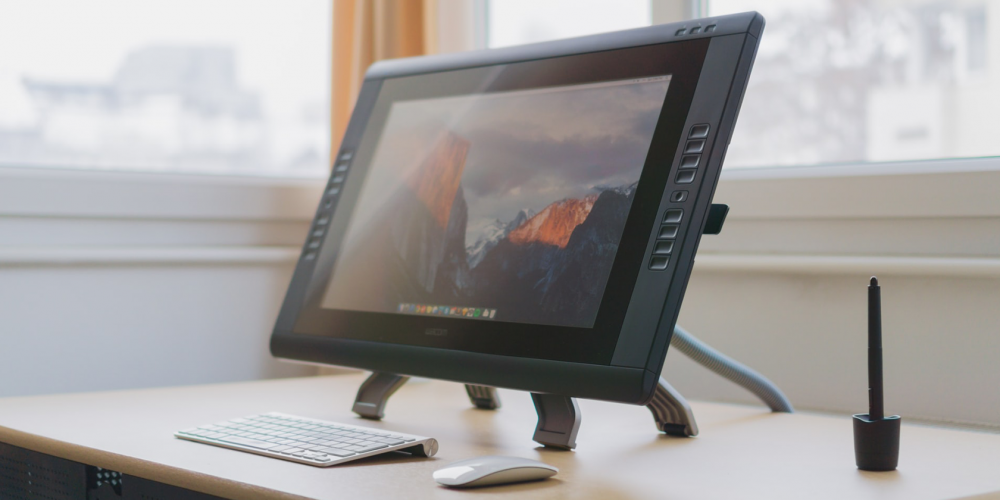
8 Things You Should Know Before Buying a Graphics Tablet
8 Things You Should Know Before Buying a Graphics Tablet
When it comes to stepping up your digital art game, there are probably few investments more worthwhile such as getting a graphics tablet or pen display. However, it can be challenging to determine what to look for when purchasing one for the first time.
Here's everything you need to know before going graphics tablet shopping.
Display vs. Non-Display
You'll need to decide whether or not you require a display on your graphics tablet, as this has a significant impact on the price.
While tablets without displays are significantly less expensive, they can take some getting used to. You'll be drawing and writing on the tablet in your hands while simultaneously looking at your computer screen. This can feel extremely strange to inexperienced digital artists.
Using a display tablet eliminates that awkward setup entirely, which simplifies the transition from traditional to digital art. Directly on the screen, drawing will have the feel of putting a pencil to paper. However, this is the more expensive option.
The Availability of Replacement Parts and Drivers
Certain graphics tablets may require additional purchases in the future. For instance, a new battery if the tablet features Bluetooth connectivity, or, more commonly, stylus tips and nibs.
This is something to bear in mind, especially if you're purchasing an older graphics tablet model or a used graphics tablet. You don't want to purchase a tablet on a good deal only to discover that the manufacturer no longer manufactures the components you'll eventually need to replace.
To truly save money on a graphics tablet, choose one that still has "refills" in stock (if applicable) and driver support (which is typically available on the manufacturer's website).
Pen Pressure or Sensitivity
Pen pressure or pen sensitivity refers to the ability of the stylus on a graphics tablet to detect the amount of pressure applied when drawing or writing. The advantage of having multiple pressure levels is that it enables you to make more precise line thickness distinctions.
Having said that, having an absurd number of levels is typically unnecessary for beginner artists, and some programs have a limit on the number of pressure levels they can handle. For the majority of graphics tablet users, 1,024 pressure levels should be sufficient.
Simply ensure that your tablet supports some form of pen pressure or pen sensitivity. Some less expensive tablets lack this feature entirely, forcing you to draw unattractive strokes with no variation in thickness or taper.
Consider Browsing In-Person
We strongly advise you to purchase your graphics tablet in person rather than ordering one online. This is so you can determine the size of your tablet and how to hold the stylus in person (if the store allows this before purchase).
The area of your tablet on which you can draw is referred to as the "active area." Larger tablets have larger active areas and are therefore more expensive. However, it may be a worthwhile investment. You can work on large artworks without having to zoom in as much, and details will be much easier to work with.
Additionally, styli come in a variety of shapes and sizes. You'll want one that fits perfectly in your hand, which you won't know until you hold it.
Don't Be Dazzled by Brand Name or High Price
Simply because a graphics tablet is made by a well-known brand or is expensive does not mean it is superior to those made by smaller brands or are less expensive. While the adage "you get what you pay for" is partially true, it is not always necessary to blow your budget on every new piece of technology.
Given their stellar reviews, it's probably very tempting to browse the Wacom and XP-Pen product lines, but don't be afraid to look at other brands. Huion, VEIKK, and UGEE all offer excellent entry-level tablets at a reasonable price.
Consider all of your options and determine which one is the best fit for your needs and budget.
Compatibility
This may seem self-evident to some, but you must ensure that the tablet you choose is compatible with your setup. While the majority of major graphics tablet brands offer full support for Windows, Mac, and Linux, it's not uncommon for more affordable options to only support Windows.
Certain tablets can also be finicky with certain programs, so if you're not a typical Photoshop or Illustrator user, we recommend looking into that as well.
Package Deals
A graphics tablet is a significant investment, which is why you should ensure you're getting the best value.
Occasionally, manufacturers of graphics tablets will partner with developers of art software to sell both together as a bundle. This means you can purchase both at a lower price than you would if you purchased the tablet and program separately.
Maintain an eye out for these specials! If a tablet includes free software, it is usually noted on the box. However, exercise caution, as some software may be region-locked (e.g. "offer only available for US customers," etc.).
Warranty
Spending a lot of money on anything can be stressful, but having a warranty on your purchase will help you breathe easier. As is the case with many other electronic purchases, warranties are frequently divided into tiers, with the more expensive tiers providing more comprehensive coverage (e.g. damage caused by handling, water, etc.).
Most drawing tablets come with a manufacturer's warranty that begins immediately upon purchase, but the duration of the warranty varies according to the tablet's brand. A good drawing tablet should come with a one-year warranty.
Courses and Certification
Computer Graphics Course and Certificate
CorelDraw Graphics Course and Certificate
Advanced Graphics and Multimedia Technologies Course and Certificate
Adobe Illustrator Course and Certificate
Adobe Fireworks Course and Certificate

